加纳一些处理粪便污泥的本土植物的发展、特性和性能评价
IF 4.4
4区 化学
Q2 POLYMER SCIENCE
引用次数: 0
摘要
在生物混凝剂/生物絮凝剂脱水领域,寻找可持续管理粪便污泥的替代解决方案仍未完成。对加纳北部一些可获得和可获得的本土植物进行了鉴定,并随后对其用作生物混凝剂/生物絮凝剂的适用性进行了评估。Yila (crosssopteryx febrifuga)和Voulo (Grewia mollis)是本研究使用的本土植物。用粪泥对不同浓度的依拉木茎、依拉树皮和伏洛进行了三种应用监测。依拉木茎对化学需氧量(COD)、总悬浮物(TSS)和浊度的去除率分别高达83.99%、93.79%和91.54%。对COD、TSS和浊度的去除率分别为77.39%、82.02%和54.60%。Voulo装置对COD、TSS和浊度的处理效率分别达到80.43%、86.83%和72.55%左右。在本研究中使用的表征原料中没有发现任何氰化物或有毒化合物。该研究揭示了使用当地天然原料生产生物混凝剂的潜力,这种混凝剂可以像合成/化学混凝剂一样有效,但大规模使用它只适用于批处理或半批处理系统。在考虑的植物中发现的一些有趣的成分,如三烷基铋和呋喃衍生物,可以开辟机会,阐明这些已确定的植物在制药、化妆品、玻璃和陶瓷、橡胶生产和其他适用的药用优势领域的潜在应用。本文章由计算机程序翻译,如有差异,请以英文原文为准。
Development, Characterisation, and Performance Evaluation of Some Indigenous Plants for Faecal Sludge Treatment in Ghana
The search for alternative solutions for sustainable management of faecal sludge in the area of dewatering with biocoagulants/bioflocculants remains unfulfilled. Some available and accessible indigenous plants in the northern part of Ghana have been characterised and subsequently evaluated in their suitability for use as biocoagulant/bioflocculants. The Yila (Crossopteryx febrifuga) and the Voulo (Grewia mollis) plants were the indigenous plants used in this study. Three applications from the Yila wooden stem, the Yila bark, and the Voulo at different treatment concentrations with faecal sludge were monitored. The Yila wooden stem gave a potential of pollutant removal up to about 83.99%, 93.79%, and 91.54% for Chemical Oxygen Demand (COD), Total Suspended Solids (TSS), and turbidity, respectively. Application of the Yila bark gave a respective removal efficiency of up to about 77.39%, 82.02%, and 54.60% for COD, TSS, and turbidity. The efficiency of the Voulo plant obtained for COD, TSS, and turbidity was up to about 80.43%, 86.83%, and 72.55%, respectively. No cyanogenic or toxic compounds were identified in the characterised raw materials used for this study. The study has revealed the potential of producing biocoagulants that can perform as effectively as synthetic/chemical coagulants using locally natural raw materials but the use of it at large scale will only be applicable for batch or semi-batch systems. Some interesting constituents identified in the plants under consideration, such as trialkyl bismuthine and furan derivative, can open up opportunities to elucidate the potential applications of these identified plants in the areas of pharmaceuticals, cosmetics, glass and ceramics, rubber production, and other applicable medicinal advantageous areas.
求助全文
通过发布文献求助,成功后即可免费获取论文全文。
去求助
来源期刊

International Journal of Polymer Science
POLYMER SCIENCE-
CiteScore
6.10
自引率
0.00%
发文量
55
审稿时长
>12 weeks
期刊介绍:
The International Journal of Polymer Science is a peer-reviewed, Open Access journal that publishes original research articles as well as review articles on the chemistry and physics of macromolecules.
 求助内容:
求助内容: 应助结果提醒方式:
应助结果提醒方式:


